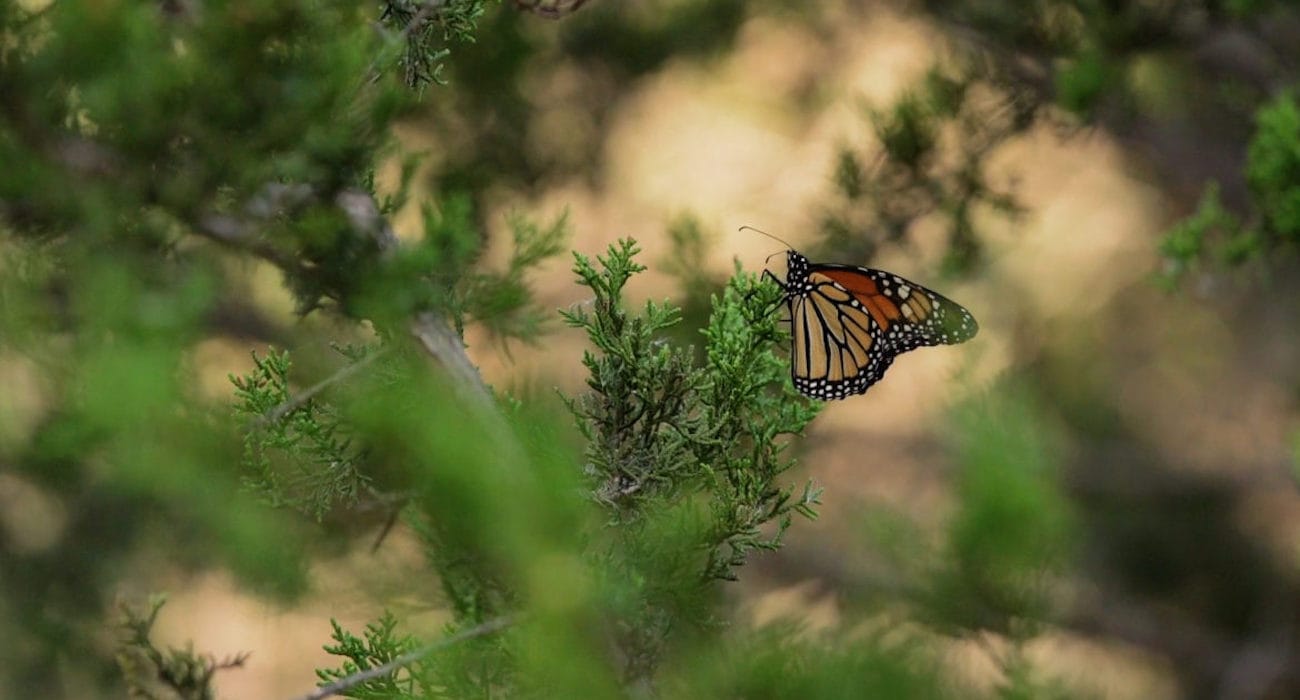Monarch Butterfly, Bee Decline Discussed at Capitol Hearing

According to the testimony reported below, honeybees and Monarch Butterflies are being harmed by genetically modified crops (GMOs) for two reasons. First, cotton no longer has pollen on which bees can feed. Second, the poisons – Roundup and neonicoinoids – with which GMO crops are grown kill bees, butterflies, many other insects and plants they need.
NOTE: this article initially appeared on July 19, 2018. TheRivardReport.com It was written by Monika Maeckle.
Experts and legislators discussed the implications of the decline of monarch butterfly and bee populations in Texas at a public hearing at the State Capitol on Wednesday.
Ben Hutchins, an invertebrate specialist for the Texas Parks and Wildlife Department (TPWD), opened the two-hour session by describing the important role insects play in providing billions of dollars in free pollination services each year. Pollinators make one of every three bites of our food possible and play a role in recreation, hunting, tourism, and cotton cultivation.
When asked by House Culture, Recreation and Tourism Committee chairman John M. Frullo (R-Lubbock) what would happen if the monarch butterfly is granted “threatened” status under the federal Endangered Species Act (ESA), Hutchins replied, “Nobody knows the answer to that.” The species was submitted for ESA consideration in 2014 and a ruling is expected by June 2019.
Several speakers said that since more than 95 percent of Texas land is owned privately, landowners can play a significant role in pollinator habitat restoration.
“We can do something about habitat loss,” said Iliana Peña, TPWD’s director of conservation programs. “It’s not an either-or situation.”
Megan Hope, a policy analyst for the Texas State Comptroller’s Office, provided an overview of the program her office has been conducting for the past three years. The office was tasked in 2015 with assessing the economic impact listing the monarch butterfly as threatened would have on the Texas economy.
Since then, the Comptrollers’ Office has awarded $800,000 to Texas universities to study the monarch, including a $300,000 grant to the University of Texas at San Antonio.
Hope said final results of the research will be shared with the U.S. Fish and Wildlife Service in August.
After the monarch butterfly experts presented their updates, members of the beekeeping community reported on the status of honey bees.
Mary Reed, an inspector for the Texas Apiary Assocation, ticked off the challenges for commercial bee keepers in the state: foul brood, a fatal spore driven disease that hasn’t hit Texas yet; varroa mites; and nosema. Reed said Texas beekeepers reflect the national averages for mites, which is the No. 1 threat to honey bee colonies.
Clint Walker, owner of Walker Honey Farm, said that because of habitat loss, pesticide use, and climate change, it’s almost impossible for Texas beekeepers to make a living producing just honey.
It wasn’t always so, said Walker, who grew up in McAllen and has been keeping bees for 50 years. Before big freezes hit citrus groves in the 1980s, honey made from orange and grapefruit blossoms was the most prized nectar product. “It’s not even on the radar today. … Orange blossom honey doesn’t even gain shelf in the grocery store.”
The most productive and profitable honey crop results from the invasive Chinese tallow tree, labeled a noxious weed by the state of Texas. “It’s the mesquite of the Gulf Coast plains,” said Walker. “It will take [over] a pasture. It’s the No. 1 honey-producing plant in Texas.”
Walker added that without Chinese tallow, honey production in Texas would be cut in half.
“Texas beekeepers relying on honey production are in peril,” he said, adding that commercial bees are typically not in Texas to produce honey. Most Texas bees start the year in California pollinating almonds, he said.
Walker also bemoaned the overuse of pesticides and genetically modified crops, specifically cotton. Cotton produces tons of nectar, he said.
“God made cotton to produce honey,” he said. “Now we’ve bred the nectar out of it. Now we don’t attract the beneficial wasps that eat the boll weevil, and we don’t get cotton honey.”
Shalene Jha, an associate professor of integrative biology at the University of Texas at Austin, echoed the importance of insect pollinators to crops like cotton. In studies she conducted working with landowners across Texas, cross pollination made possible by insect pollinators – even in self-pollinating crops like cotton – yielded higher boll sizes, increased weight and more profit for farmers.
Cotton bolls were 18 percent heavier when pollinated by insects versus self-pollination, said Jha. “The per-boll increase equals $118 per acre more in profits,” she said, adding that similar results occurred with melons and blueberries.
The session ended with a report on a partnership between a Canadian oil company and the Texas Native Seeds project at the Caesar Kleberg Wildlife Research Institute to develop local ecotype native plant seeds for use in pollinator habitat restorations.
Canadian oil company Enbridge Corp. announced in January it would work with Forrest Smith, the seed project’s director, to develop local ecotype seeds for a 42-mile segment of the company’s Valley Crossing Pipeline, which runs through the King Ranch and Kenedy County in South Texas. The pipeline right-of-way will double as a “pollinator pathway” for migratory monarch butterflies and other wildlife, said Devin Hotzel, an Enbridge official.
Enbridge awarded a $100,000 grant to the Caesar Kleberg Wildlife Research Institute to develop appropriate local ecotype seed mixes to be used in the restoration. The partnership convinced other landowners to participate.
“We’re really proud of this effort,” said Hotzel.
Since the announcement of the restoration initiative, colleagues in the oil industry have expressed interest in replicating the effort, he said.
“They’re interested in what we’re doing – not what it cost, but how to do it, too,” he said. “It’s a testament to the power of industry and the community to work together to provide solutions.”



